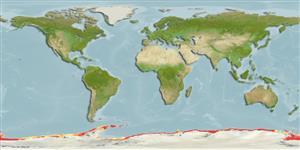>
Perciformes/Notothenioidei (Icefishes) >
Artedidraconidae (Barbled plunderfishes)
Etymology: Pogonophryne: Greek, pogon = beard + Greek, phrynos = toad (Ref. 45335).
Eponymy: Robert Falcon Scott (1868–1912) was a British naval officer and Antarctic explorer. His biographies are extensive, so need not be repeated here. (Ref. 128868), visit book page.
More on author: Regan.
Environment: milieu / climate zone / depth range / distribution range
Ekologi
laut batidemersal; kisaran kedalaman 100 - 1180 m. Deep-water; 60°S - 78°S
Southern Ocean: east Antarctica (Davis, Ross and Weddell seas), Antarctic Peninsula, South Shetland Islands and South Orkney Islands.
Size / Weight / umur
Maturity: Lm ? range ? - ? cm
Max length : 31.0 cm TL jantan/; (Ref. 5181)
Amphipods were the main food of fishes from the Weddell Sea, although isopods, mysids and polychaetes were important food items (Ref. 5181).
Life cycle and mating behavior
Kematangan | Reproduksi, perkembang biakan | Pemijahan | telur-telur | Fecundity | Larva
Eakin, R.R., 1990. Artedidraconidae. p. 332-356. In O. Gon and P.C. Heemstra (eds.) Fishes of the Southern Ocean. J.L.B. Smith Institute of Ichthyology, Grahamstown, South Africa. (Ref. 5181)
Status IUCN Red List (Ref. 130435: Version 2024-2)
ancaman kepada manusia
Harmless
penggunaan manusia
Perikanan: tidak ada kepentingan
Alat, peralatan
laporan khas
muat turun XML
Sumber internet
Estimates based on models
Preferred temperature (Ref.
123201): -1.8 - 1.2, mean -0.8 °C (based on 1358 cells).
Phylogenetic diversity index (Ref.
82804): PD
50 = 0.5000 [Uniqueness, from 0.5 = low to 2.0 = high].
Bayesian length-weight: a=0.00631 (0.00364 - 0.01094), b=3.27 (3.11 - 3.43), in cm total length, based on LWR estimates for this species & (Sub)family-body (Ref.
93245).
Trophic level (Ref.
69278): 3.5 ±0.53 se; based on food items.
Fishing Vulnerability (Ref.
59153): Low vulnerability (21 of 100).
